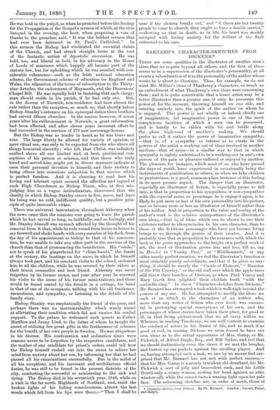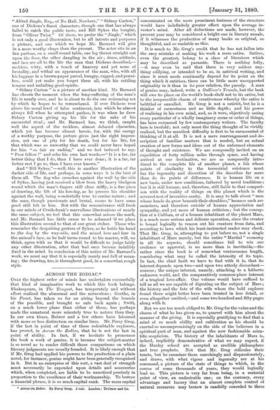B.A_RNARD'S CHARACTER-SKETCHES FROM DICKENS.*
THERE are some qualities in the illustrator of another man's ideas that we require beyond all others, and the first of these seems to be a suppression of the illustrator's personality, at all events a subordination of it to the personality of the author whose works he is about to illustrate. Thus, for example, we do not want Mr. Millais's ideas of Thackeray's characters, so much as an embodiment of what Thackeray's own ideas were concerning them ; and it is quite conceivable that a lesser artist may be a better illustrator than a greater one, if only he possesses this power of, for the moment, throwing himself on one side, and. entering entirely into the spirit of the author on whom he is engaged. This power is not wholly or indeed chiefly one of imagination, for imaginative power is one of the most conspicuous faculties of which a man can be possessed, and is hardly to be ridden with bit and bridle along the plain high-road of another's making. We should prefer to call it rather the power of imaginative sympathy, —that is, of a sympathy so intense as to create in the powers of the artist a working out of ideas received in another medium—that of prose—in a similar way to that in which sympathy is rightly understood to be a working-out in one's own person of the pain or pleasure suffered or enjoyed by another. The pleasure, for instance, which most of us who have passed the days of youth, have experienced in occasionally being the instruments of gratification to others, as when we take children to pantomimes, is a good, common-place instance of this feeling in its more prosaic aspect. The danger that an illustrator, especially an illustrator of fiction, is especially prone to fall into, is that in proportion to his sympathies or non-sympathies with the especial scene or personage he is engaged upon, is he likely to put more or less of his own personality into his picture, and so become more or less an illustrator of himself rather than of his author. And in proportion to the value and reality of the author's work is the relative unimportance of the illustrator's own ideas,—that is, of ideas which can be shown to owe their existence rather to idiosyncracies in his own character, than to those of the fictitious personages who have yet become living beings to us through the genius of their creator. And it is probably true that in proportion to the nearness with which the book or the poem approaches to the height of a perfect work of art, the need of illustration grows less and less, till as, say in Hamlet or "Vanity Fair," or " Middlemarch," or any other nearly perfect creation, we feel the illustrator's function is most certainly purely subordinate, and that if he gives us any- thing, it should be merely the "Castle of Elsinore," "Mansion of Sir Pitt Crawley," or the old wall over which the apple-trees still throw their bunches of blossom, as when Fred Vincey and Mary Garth first plighted their childish troth "with the umbrella-ring." In these "Character-sketches from Dickens," Mr. Barnard has attempted a task which is well-nigh beyond the powers of any one. He has attempted to modify the ideas we each of us attach to the characters of an author who, more than any writer of fiction who ever lived, was success- ful in portraying special conceptions of his own, and the personages of whose stories have taken their place, for good or ill, in that living picture-work that we all carry within us. Whereas, in reading Thackeray, we are well content to examine the conduct of actors in his drama of life, and to mark it as good or evil, in reading Dickens we seem forced to have our own ideas as to the actual appearance of Mrs. Gamp, or Mr. Pickwick, of Alfred Jingle, Esq., and Bill Sykes, and feel that we should instinctively cross the street if we met the burglar, and button up our pockets against the strolling player. And so, having attempted such a task, we can by no means feel sur- prised that Mr. Barnard has not met with perfect success,— that his Mrs. Gamp is a merely truculent old drunkard, his Mr. Pickwick a sort of jolly and benevolent cook, and his Little Dorrit only a weary woman, resting her head against an attic window-sill, while the sunset casts a waning light upon her pale face. The redeeming sketches are, in order of merit, those of * Character-Sketches from Dickens. By Mr. Barnard. London : Cassell, Petter, and Gilpin.
"Alfred Jingle, Esq., of No Hall, Nowhere," "Sidney Carton," one of Dickens's finest characters, though one that has always failed to catch the public taste, and Bill Sykes the burglar, from "Oliver Twist." Of these, we prefer the "Jingle," which is not only a good illustration, but to all intents and purposes a picture, and one which we hope Mr. Barnard will give in a more worthy shape than the present. The actor sits in an inn parlour, on a small round table, one leg thrust straight out upon the floor, the other dangling in the air ; dress, attitude, and face are all to the life the man that Dickens described,— reckless, witty, with a touch of knavery and yet none of brutality, and withal an appearance of the man, who, with all his luggage in a brown-paper parcel, hungry, ragged, and penni- less, could yet make you forget them all, with his rattling tongue and unfailing good-spirits.
"Sidney Carton" is a picture of another kind. Mr. Barnard has chosen the moment when the long-suffering of the man's life is nearly over, and he is about to do the one redeeming act by which he hopes to be remembered. If ever Dickens rose above his usual level of false sentiment, into which he almost always fell when he attempted pathos, it was when he drew Sidney Carton giving up his life for the sake of his successful rival ; and Mr. Barnard has, we think, caught well the aspect of the reckless, almost debased character, which yet has become almost heroic, for, with the energy of a worthy purpose, the picture gives just the right impres- sion, not one of pity for his death, but for his life, for that which was so unworthy that we could never have hoped for him "so fair an ending," and we feel induced to say, "Poor fellow !" and echo his own last words,—" It is a far, far better thing that I do, than I have ever done; it is a far, far better rest I go to, than I have ever known."
And "Bill Sykes,"—well, this is another illustration of the darker side of life, and perhaps, in some ways it is the best of them all. The dog who crouches against the wall by the side of Sykes, having just received a blow from the heavy bludgeon round which the man's fingers still close stiffly, is a fine piece of drawing, the lift of his fore-leg, as he presses his shoulder against the wall, being wonderfully true to canine nature; and the man, though passionate and brutal, seems to have some good still left in him. But with the remembrance still fresh in our minds of Cruikshank's marvellous illustrations of nearly the same subject, we feel that this somewhat misses the mark, and Mr. Barnard has little cause to be ashamed if we place this illustration second to that of our great etcher. Those who remember the despairing gesture of Sykes, as he holds his hand to the dog by the way-side, and the mixed love and fear in the animal's face, as he half turns round to his master, will, we think, agree with us that it would be difficult to judge fairly any other illustration, after that had once become indelibly fixed in the mind. In conclusion of this notice of Mr. Barnard's work, we must say that it is especially manly and full of mean- ing; the drawing, too, is throughout good, in a somewhat.rough style.



































 Previous page
Previous page